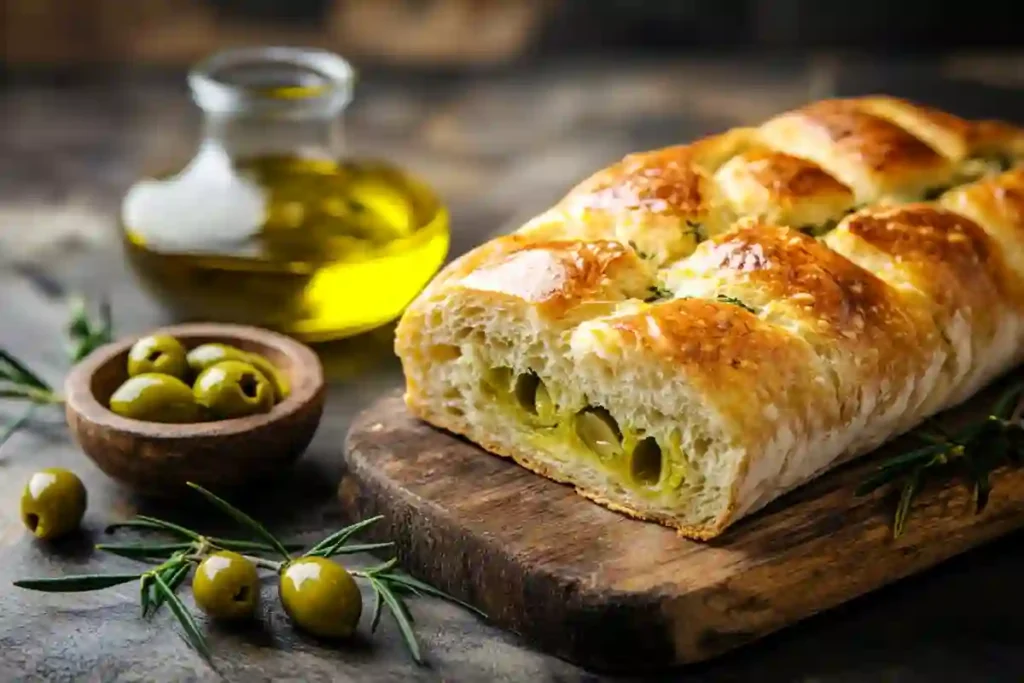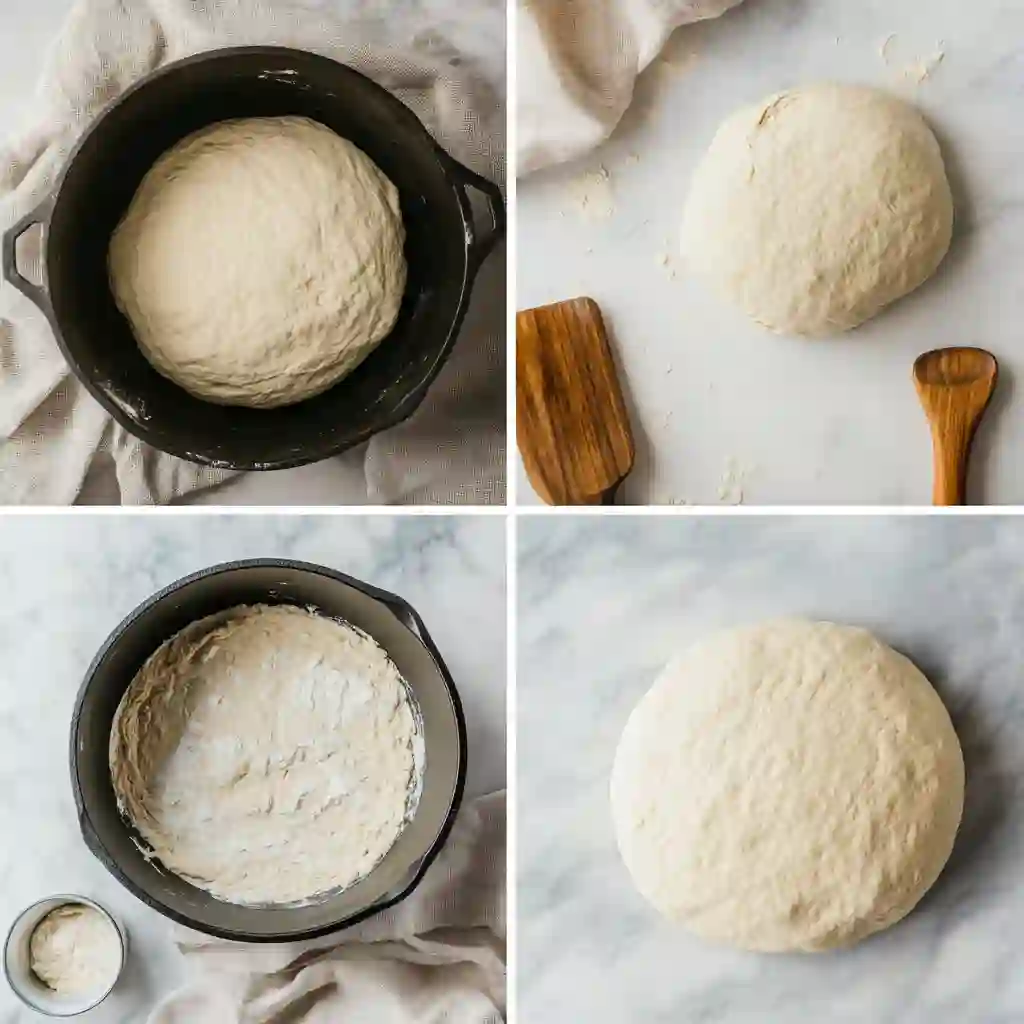
Table of Contents
Craving that crusty, chewy slice of rustic bread bursting with briny flavor? This green olive bread recipe delivers Mediterranean charm in every bite, and the best part—it’s no-knead and foolproof. Whether you’re dipping it in olive oil, building a sandwich, or serving it alongside soup, this loaf makes any meal feel special. In this article, I’ll walk you through my go-to method, share tricks to perfect the rise and crust, and answer those burning olive bread questions (yes, you can totally use green olives!). Let’s turn pantry basics into a golden loaf that’s fresh, fragrant, and full of life.
Why Green Olive Bread Has a Story to Tell
Baking with a Memory
Some recipes take you back to a place so vivid, you can almost smell the air. The first time I tasted freshly baked green olive bread, I was standing in the back kitchen of a small rustic inn nestled in the hills of Andalusia.
I remember the warmth of the room, the flour-dusted countertops, and the baker’s hands—strong and sure—folding green olives into soft dough like it was second nature. Years later, standing in my own Portland kitchen, I set out to recreate that exact experience with my own version of a green olive bread recipe.
hat first loaf I baked had a crust so crisp it cracked when I sliced into it, and the inside was soft, airy, and dotted with plump green olives. It was magic—and it instantly became a household favorite. Now, every time I make this bread, I think of how something so simple can transport you with just five ingredients and a little time.
The Secret’s in the Olives
What makes this loaf stand out is, hands down, the olives. Not just any olives—green ones, with their firm bite and bright, briny character. While many folks lean toward black or Kalamata, I’ve found that green olives give this bread a cleaner, fruitier flavor that works beautifully with the chewy texture of the crumb.
I like using buttery Castelvetrano olives or the kind you’d find in a jar of marinated green olives, where the herbs and citrus have already done some flavor lifting.
If you’re curious about what makes green olives so versatile in the kitchen, you can read more about their background and varieties on our full green olives overview page. Their subtle bitterness mellows out as they bake, creating flavor pockets that surprise you with every bite.
Whether you’re serving this loaf with a hearty winter soup or slicing it thin for toast and tapenade, this green olive bread recipe is a true keeper.
Getting the Dough Just Right
Ingredients You’ll Need

This green olive bread recipe keeps things simple with just a few high-quality ingredients. Each one plays a crucial role in flavor and texture.
| Ingredient | Quantity | Notes |
|---|---|---|
| Bread flour | 3 ½ cups (420g) | High gluten content for chewy texture |
| Kosher salt | 1 tsp | Balances flavor |
| Instant yeast | ¾ tsp | No need to bloom |
| Water | 1 ⅓ cups (320 ml) | Room temperature |
| Green olives | 1 packed cup (150g) | Pitted and chopped – use [green olive paste](https://plantpoweredrecipe.com/olives-mediterranean/green-olive-paste-recipe/) for a smoother variation |
| Extra virgin olive oil | 1 tbsp | Adds moisture and olive richness |
Step-by-Step Instructions
1. Mix the Dough (Evening Before Baking)
Start by whisking together bread flour, salt, and instant yeast in a large bowl. Fold in the chopped green olives or a spoonful of flavorful green olive tapenade for an extra hit of Mediterranean goodness. Add water and olive oil, then stir until the dough forms a sticky, shaggy ball. It will look rustic—don’t worry, that’s exactly how it should be.
2. Let It Rise Overnight
Cover the bowl tightly and let the dough rest at room temperature for 12–18 hours. During this time, the yeast will work its magic, transforming the dough into a bubbly, airy masterpiece. If you’ve ever used marinated green olives in dishes before, you’ll appreciate how their savory brine infuses this bread overnight.

3. Shape the Dough
Dust your counter with flour, gently turn out the dough, and fold it inward to shape into a ball. Use floured hands or a dough scraper to help guide the shape without overworking the dough.
4. Second Rise (2 Hours)
Place the shaped dough on a floured tea towel, seam side down, inside a bowl. Let it rise in a warm spot for about two hours. When ready, it should spring back slowly when gently poked.
5. Preheat and Prepare Your Oven
Thirty minutes before baking, place a Dutch oven into the oven and preheat to 475°F. When the dough is ready, flip it onto parchment paper.
6. Bake the Bread
Using oven mitts, carefully lower the parchment-lined dough into the hot Dutch oven. Cover and bake for 30 minutes. Take off the lid and continue baking uncovered for 20 minutes, or until the crust turns a deep golden brown.
7. Cool Completely
Transfer the baked loaf to a wire rack and allow it to cool for at least one hour before slicing. This resting time is essential to lock in flavor and texture.
Bonus Tip
For a deeper understanding of olive oil’s health properties in baking, read this expert guide on olive oil benefits. Choosing a high-quality oil elevates both nutrition and flavor in your loaf.
Whether you’re folding in cracked green olives for added texture or pairing a slice with green olive soup, this bread brings the best of the green olive pillar straight to your table.
Flavor Add-Ins and Serving Ideas
Zest, Herbs, and Flavor Twists
Once you’ve mastered the base green olive bread recipe, it becomes a blank canvas for flavor. The olives already offer boldness, but you can layer in herbs, citrus, and even roasted vegetables to create a more personalized loaf. These flavor add-ins are mixed right into the dough during the initial stir.
| Add-In | Amount | Flavor Profile |
|---|---|---|
| Fresh rosemary, thyme, or oregano | 1–2 tablespoons, chopped | Herbaceous, earthy |
| Lemon or orange zest | 1 tablespoon | Bright, citrusy |
| Roasted garlic cloves | 1 head, peeled | Savory, mellow sweet |
| Sun-dried tomatoes (optional) | ¼ cup, chopped | Tangy, umami-rich |
You can add any of these during the mixing step with your green olives. The herbs and garlic especially pair well with the salty brightness of olives. For even more depth, consider substituting part of the chopped olives with a swirl of green olive paste for smoother bites and rich Mediterranean undertones.
How to Serve It Up
Green olive bread is incredibly versatile. Serve it as an appetizer, part of a main course, or even as a star on a mezze platter. It’s especially perfect when paired with other Mediterranean-forward dishes.
- For a cozy, savory combo, ladle up a bowl of this green olive soup and add a thick slice of freshly baked bread.
- Toasted slices make a perfect vehicle for hummus, green olive tapenade, or simple olive oil dips.
- You can also serve it warm with a spread of marinated green olives and herbs for a rustic starter board.
And if you’re thinking big picture, try slicing it thin and layering it into sandwiches or even as the base for a creative green olive pizza. The bread’s structure holds up beautifully under pressure—and flavor.
Pro Tips, Storage & Long-Term Love for Green Olive Bread
Handling Sticky Dough & Common Mistakes
If you’re new to no-knead bread, the wet and sticky dough might feel intimidating at first—but don’t panic. That high hydration is what gives this bread its open crumb and chewy bite. Here’s how to manage the process with ease:
- Use a dough scraper or floured hands when shaping. Avoid adding excess flour directly to the dough.
- If the dough doesn’t rise overnight, your yeast might be inactive. Use fresh, instant yeast for the most consistent rise.
- During the second proof, place the dough in a slightly warm, draft-free area. Too cold, and it may not rise in time.
To avoid over-proofing, use the finger poke test: gently press the dough—if it springs back slowly, it’s ready for baking.
And for extra peace of mind, bake with a thermometer. The bread is done when the internal temperature hits 190°F to 200°F.
Storing, Freezing & Bringing It Back to Life
Homemade bread doesn’t have preservatives, but that’s part of the appeal. With just a little planning, you can keep it fresh and delicious longer.
| Storage Method | Instructions | Shelf Life |
|---|---|---|
| Room temperature | Store cut side down on a wooden board or wrapped in paper | 2–3 days |
| Freezer | Wrap tightly in foil and freeze; thaw at room temp | Up to 3 months |
| Reheating | Bake at 350°F for 10–15 min to refresh crust | As needed |
Want to turn leftover slices into something special? Brush them with olive oil and toast for crostini, or serve alongside this savory Spanish rice with green olives.
And remember—just like olives themselves, this bread only gets better when paired thoughtfully. Try it with a mezze spread, soups, or that humble weekday lunch in need of a serious upgrade.
FAQ
Can you use green olives in bread?
Yes, and they’re a perfect fit. Green olives have a firmer texture and tangier bite than black olives, which means they hold their shape and flavor better in bread.
What is the best flour for olive bread?
Bread flour is ideal. It contains more protein than all-purpose flour, helping build the gluten structure needed to support the olives and create a chewy crumb. You can use all-purpose flour in a pinch, but the texture will be softer. If you’re experimenting, try blending in whole wheat flour for a rustic spin.
Is olive loaf just bologna with olives?
Nope. That’s a common mix-up. “Olive loaf” typically describes a type of deli meat that contains chopped olives mixed throughout. This is completely different—an artisan-style, crusty bread with green olives worked into the dough. There’s no meat, just plant-powered goodness.
How healthy is olive bread?
Pretty healthy, especially when homemade. This bread contains heart-healthy fats from the olives and olive oil, no added sugar, and no preservatives. You can make it even more nutrient-dense by adding whole grains or herbs. Enjoy it in moderation as part of a balanced, plant-forward diet.
Conclusion
This green olive bread recipe isn’t just bread—it’s an experience. From the first mix to the final golden crust, it offers a taste of the Mediterranean in your own kitchen. Whether you’re dipping warm slices into olive oil, sandwiching your favorite fillings, or pairing it with green olive soup, every bite reminds you of how simple ingredients can become something truly special.
Print
Green olive bread recipe
- Total Time: 13 hours
- Yield: 1 large loaf 1x
- Diet: Vegan
Description
A crusty, no-knead green olive bread recipe packed with Mediterranean flavor, perfect for dipping, slicing, and sharing.
Ingredients
3 ½ cups bread flour
1 tsp kosher salt
¾ tsp instant yeast
1 ⅓ cups water
1 cup green olives, chopped
1 tbsp extra virgin olive oil
Instructions
Whisk together flour, salt, yeast, and olives in a large bowl.
Stir in water and olive oil until a rough dough forms.
Cover and let rise for 12–18 hours at room temperature.
Turn dough onto a floured surface and shape into a ball.
Let rest for 2 hours on a floured towel.
Preheat Dutch oven to 475°F and transfer dough with parchment.
Bake covered for 30 minutes, then uncovered for 20 minutes.
Cool completely on wire rack before slicing.
Notes
For added flavor, try folding in fresh herbs, citrus zest, or roasted garlic.
You can also swirl in green olive paste for richer texture.
This loaf pairs perfectly with tapenade, soup, or hummus.
- Prep Time: 12 hours
- Cook Time: 50 minutes
- Category: Bread
- Method: No-knead
- Cuisine: Mediterranean
Nutrition
- Serving Size: 1 slice
- Calories: 140
- Sugar: 0g
- Sodium: 320mg
- Fat: 5g
- Saturated Fat: 0.5g
- Unsaturated Fat: 4.2g
- Trans Fat: 0g
- Carbohydrates: 20g
- Fiber: 2g
- Protein: 4g
- Cholesterol: 0mg
Keywords: green olive bread, Mediterranean bread, olive loaf
